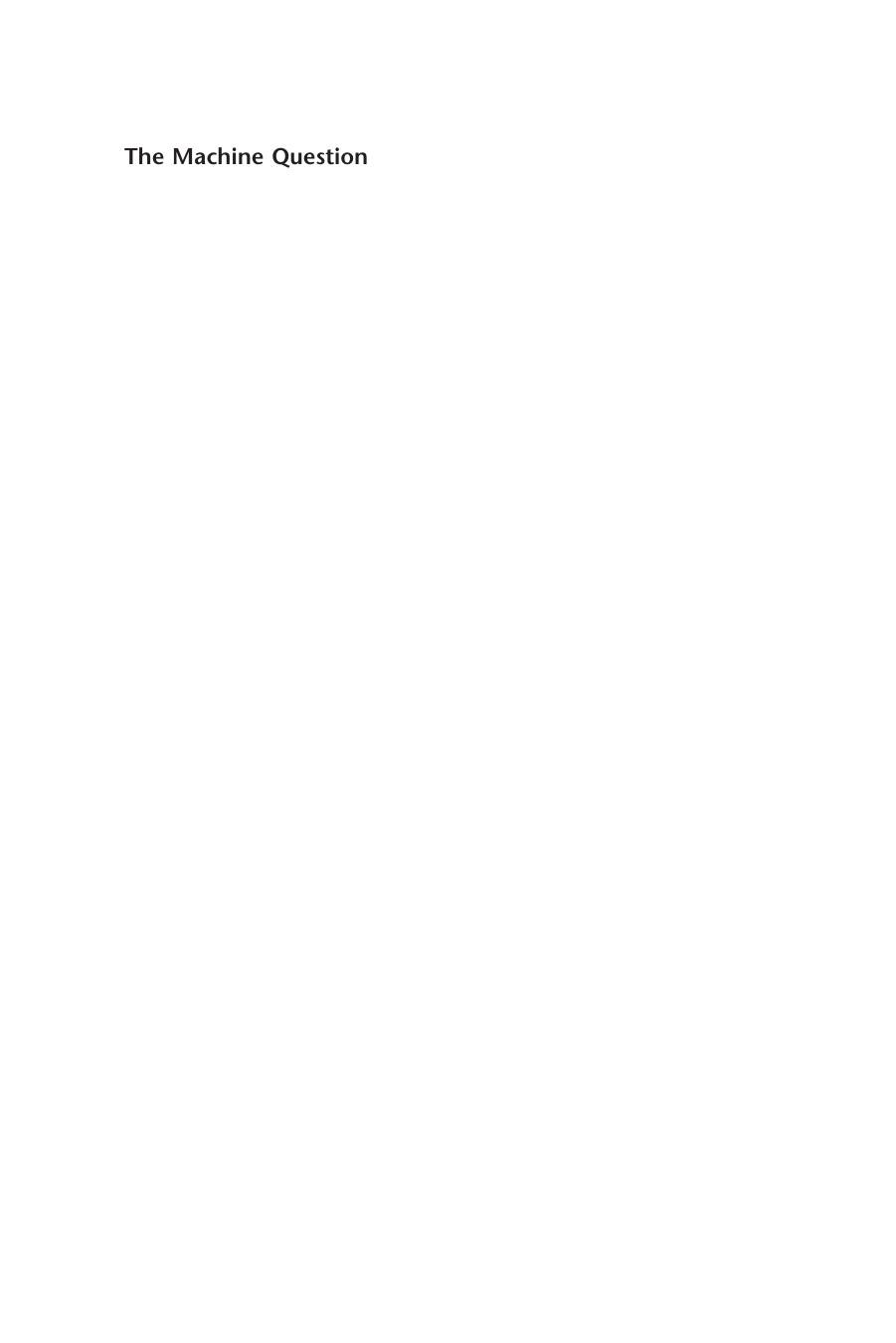The Machine Question: Critical Perspectives on AI, Robots, and Ethics by David J. Gunkel

Author:David J. Gunkel [Gunkel, David J.]
Language: eng
Format: epub, pdf
ISBN: 9780262017435
Amazon: 0262017431
Publisher: The MIT Press
Published: 2012-07-13T00:00:00+00:00
Chapter 2
bodily expression. It is neither trope-free nor a fantastic kind of “ natural
authenticity. ” It is instead a reciprocal exchange situated in the meeting
of the gaze of an other. It is a “ co-constitutive naturalcultural dancing ”
illustrated by, as Haraway presents it in considerable detail, the demanding
sport of canine agility. And the operative question in these circumstances
is not Bentham ’ s “ Can they suffer? ” but “ Can animals play? Or work? And
even, can I learn to play with this cat? ” (Haraway 2008, 22). In these playful
encounters, Haraway emphasizes, the participants
“ do not precede the
meeting ” (ibid., 4) but fi rst become who and what they are in the course
of their interactions with each other. This reconceptualization of commu-
nication, where the interacting subjects are a product of the relationship
and not some preexisting substance, clearly has promise for both sides of
the “ companion species ” relationship, and Haraway describes it in a way
that is careful to avoid simply slipping back into the language of metaphys-
ics and the metaphysics of language.
Despite this promising development, however, Haraway ’ s account rede-
ploys that other metaphysical privilege — the privileging of vision, the eyes,
and the gaze of the other. It is only those others who look back with eyes
that are capable of meeting her eyes “ face-to-face in the contact zone ”
(ibid., 227) that are considered to be capable of engaging in this kind of
nonlinguistic communication. For Haraway, then, companion species are,
in more ways than one, indissolubly connected to optics:
In recent speaking and writing on companion species I have tried to live inside the
many tones of regard/respect/seeing each other/looking back at/meeting/optic-hap-
tic encounter. Species and respect are in optic/haptic/affective/cognitive touch: they
are at table together; they are messmates, companions, in company, cum panis . I
also love the oxymoron inherent in “ species ” — always both logical type and relent-
less particular, always tied to specere and yearning/looking toward respecere . . . . The ethical regard that I am trying to speak and write can be experienced across many
sorts of species differences. The lovely part is that we can know only by looking and
by looking back. Respecere. (Ibid., 164)
This formulation, whether intended or not, has the effect of privileging
particular kinds of animals as companion species, dogs for instance, but
even some mice and cats, where the eyes are situated on the face in
such a way as to be able to meet our gaze, and tends to exclude anything
that does not and is structurally unable to come eye to eye or face to
face with the human subject. The “ ethical regard ” that occupies Haraway,
therefore, is something that is exclusively situated in the eyes, the
Moral Patiency
125
proverbial window to the soul. It is about looking and looking back at
each other that ultimately matters. Consequently, Haraway
’ s ethics of
respect for companion species not only capitalizes on the basic innovations
of Levinasian ethics, which characterizes moral consideration as the face-
to-face encounter with the Other, but also inherits one of its persistent and
systemic diffi culties — a conceptualization of
“ face ” that remains, if not
human, then at least humanist.
Download
The Machine Question: Critical Perspectives on AI, Robots, and Ethics by David J. Gunkel.pdf
This site does not store any files on its server. We only index and link to content provided by other sites. Please contact the content providers to delete copyright contents if any and email us, we'll remove relevant links or contents immediately.
Whiskies Galore by Ian Buxton(41817)
Introduction to Aircraft Design (Cambridge Aerospace Series) by John P. Fielding(33050)
Small Unmanned Fixed-wing Aircraft Design by Andrew J. Keane Andras Sobester James P. Scanlan & András Sóbester & James P. Scanlan(32732)
Craft Beer for the Homebrewer by Michael Agnew(18125)
Turbulence by E. J. Noyes(7922)
The Complete Stick Figure Physics Tutorials by Allen Sarah(7292)
Kaplan MCAT General Chemistry Review by Kaplan(6853)
The Thirst by Nesbo Jo(6812)
Bad Blood by John Carreyrou(6525)
Modelling of Convective Heat and Mass Transfer in Rotating Flows by Igor V. Shevchuk(6379)
Learning SQL by Alan Beaulieu(6192)
Weapons of Math Destruction by Cathy O'Neil(6119)
Man-made Catastrophes and Risk Information Concealment by Dmitry Chernov & Didier Sornette(5907)
Digital Minimalism by Cal Newport;(5634)
Life 3.0: Being Human in the Age of Artificial Intelligence by Tegmark Max(5449)
iGen by Jean M. Twenge(5353)
Secrets of Antigravity Propulsion: Tesla, UFOs, and Classified Aerospace Technology by Ph.D. Paul A. Laviolette(5300)
Design of Trajectory Optimization Approach for Space Maneuver Vehicle Skip Entry Problems by Runqi Chai & Al Savvaris & Antonios Tsourdos & Senchun Chai(4996)
Electronic Devices & Circuits by Jacob Millman & Christos C. Halkias(4892)
